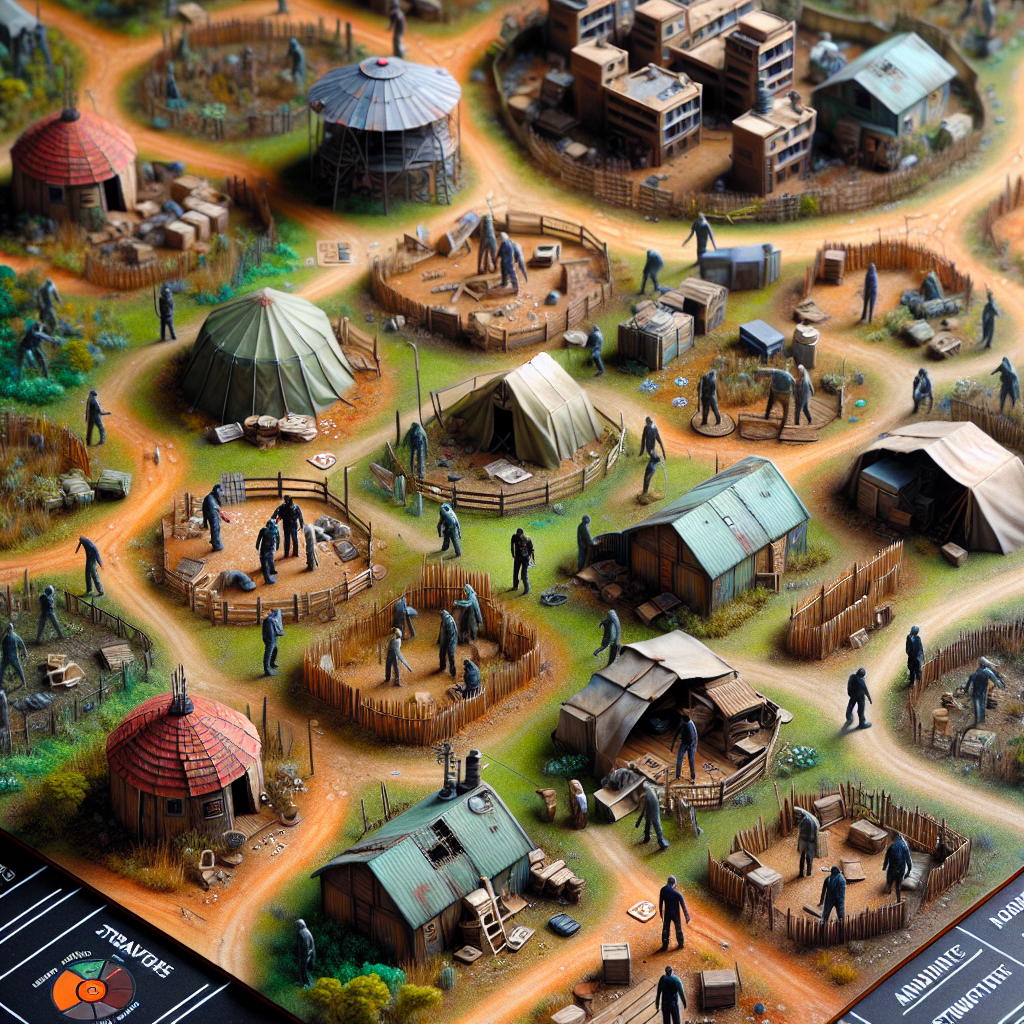“State of Survival” by KingsGroup Holdings is a strategy mobile game set in a post-apocalyptic world overrun by zombies. Version 4.1 of the game introduces enhanced gameplay mechanics, new strategic elements, and improved user interface features. Players must build and fortify their settlements, recruit and train survivors, and form alliances to fend off zombie hordes and rival factions. The update focuses on refining the balance between resource management, tactical combat, and cooperative gameplay, ensuring a more immersive and challenging experience for both new and veteran players.
Mastering Alliance Strategies in State of Survival 4.1
In the ever-evolving world of State of Survival, mastering alliance strategies is crucial for success, particularly in the latest update, version 4.1. This update has introduced several new features and adjustments that necessitate a refined approach to alliance management and coordination. Understanding these changes and effectively implementing strategic measures can significantly enhance an alliance’s performance and overall game experience.
To begin with, the importance of communication within an alliance cannot be overstated. The new update has improved the in-game chat system, making it more user-friendly and efficient. Utilizing this tool to its fullest potential is essential for coordinating attacks, sharing resources, and providing support to fellow members. Regularly scheduled meetings and discussions can help ensure that all members are on the same page and working towards common goals. Additionally, the use of external communication platforms, such as Discord or Line, can further enhance coordination and foster a sense of community among alliance members.
Resource management is another critical aspect that has been impacted by the 4.1 update. The introduction of new buildings and technologies requires alliances to be more strategic in their resource allocation. Prioritizing the construction and upgrading of key structures, such as the Alliance Headquarters and Research Center, can provide significant benefits in terms of increased resource production and enhanced combat capabilities. Furthermore, sharing resources among alliance members can help ensure that everyone has the necessary materials to progress and contribute to the alliance’s overall success.
The update has also introduced new events and challenges that require a coordinated effort from the entire alliance. Participating in these events can yield valuable rewards and boost the alliance’s standing in the game. To maximize the benefits of these events, it is essential to develop a clear strategy and assign specific roles to alliance members based on their strengths and capabilities. For example, some members may excel in gathering resources, while others may be more effective in combat. By leveraging the unique skills of each member, the alliance can achieve greater success in these events.
In addition to in-game events, the 4.1 update has also brought changes to the alliance war system. The new mechanics require alliances to be more strategic in their approach to warfare. Coordinating attacks and defenses, as well as timing them effectively, can make a significant difference in the outcome of battles. It is crucial to scout enemy alliances and gather intelligence on their strengths and weaknesses before launching an attack. This information can help in devising a more effective battle plan and minimizing losses.
Moreover, fostering a sense of camaraderie and loyalty within the alliance is vital for long-term success. The new update has introduced various social features that can help strengthen the bonds between members. Organizing regular social events, such as in-game gatherings or friendly competitions, can help build a strong sense of community and encourage members to remain active and engaged. Recognizing and rewarding the contributions of individual members can also boost morale and motivate them to continue supporting the alliance.
In conclusion, mastering alliance strategies in State of Survival 4.1 requires a multifaceted approach that encompasses effective communication, resource management, event participation, strategic warfare, and fostering a strong sense of community. By understanding and adapting to the changes introduced in the latest update, alliances can enhance their performance and achieve greater success in the game. The key lies in leveraging the unique strengths of each member and working together towards common goals, ultimately creating a more cohesive and powerful alliance.
Top Tips for Efficient Resource Management in State of Survival 4.1

In the ever-evolving world of State of Survival by KingsGroup Holdings, efficient resource management is paramount to ensuring your survival and success. As the game progresses, players must navigate through various challenges, from building and upgrading facilities to training troops and researching technologies. To thrive in this post-apocalyptic environment, it is essential to adopt a strategic approach to resource management. This article provides top tips for efficient resource management in State of Survival 4.1, guiding you through the intricacies of optimizing your resources.
First and foremost, understanding the different types of resources and their uses is crucial. The primary resources in State of Survival include food, wood, metal, gas, and biocaps. Each resource serves a specific purpose, such as food for troop upkeep, wood for building construction, metal for advanced upgrades, gas for high-level research, and biocaps for premium purchases. By recognizing the importance of each resource, players can prioritize their collection and allocation effectively.
One of the most effective strategies for resource management is to maintain a balanced production. Ensure that your resource-generating buildings, such as farms, lumber mills, and gas tanks, are upgraded regularly to maximize output. Additionally, it is advisable to invest in research that enhances resource production rates. By doing so, you can create a steady flow of resources, reducing the risk of shortages during critical moments.
Another key aspect of resource management is efficient storage. Upgrading your storage facilities is essential to prevent resource overflow and wastage. When your storage buildings reach their capacity, any additional resources collected will be lost. Therefore, it is imperative to keep an eye on your storage levels and upgrade them as needed. This will allow you to accumulate resources over time, providing a buffer for future needs.
Moreover, participating in events and completing daily tasks can significantly boost your resource reserves. Events often offer valuable rewards, including resources, speed-ups, and biocaps. By actively engaging in these events, you can supplement your resource income and accelerate your progress. Similarly, daily tasks provide a consistent source of resources and should not be overlooked. Completing these tasks regularly will ensure a steady influx of essential materials.
Trading and alliances also play a vital role in resource management. Joining an active alliance can provide numerous benefits, including resource sharing and protection. Alliances often have resource-sharing programs where members can request and donate resources to each other. This collaborative approach can help mitigate resource shortages and foster a supportive community. Additionally, trading with other players can be a strategic way to acquire specific resources that you may be lacking.
Furthermore, it is important to manage your resource expenditure wisely. Prioritize essential upgrades and avoid unnecessary spending. For instance, focus on upgrading buildings and technologies that directly impact your resource production and storage capacities. Similarly, be mindful of troop training and deployment costs. While having a strong army is crucial, overextending your resources on troop training can lead to imbalances and hinder your overall progress.
Lastly, utilizing resource boosts and items can provide a significant advantage. The game offers various boosts and items that can temporarily increase resource production rates or provide instant resources. These can be particularly useful during critical moments, such as preparing for an attack or completing a major upgrade. By strategically using these boosts, you can optimize your resource management and stay ahead of the competition.
In conclusion, efficient resource management in State of Survival 4.1 requires a comprehensive understanding of resource types, balanced production, efficient storage, active participation in events, strategic trading, wise expenditure, and the judicious use of boosts. By implementing these top tips, players can ensure a steady flow of resources, enabling them to thrive in the challenging world of State of Survival.
Advanced Combat Tactics for State of Survival 4.1 Players
State of Survival, developed by KingsGroup Holdings, has captivated players worldwide with its intricate blend of strategy, combat, and survival elements. As the game evolves, so too must the tactics employed by its players. Version 4.1 introduces several new features and adjustments, necessitating a deeper understanding of advanced combat tactics to maintain a competitive edge. This article aims to provide players with a comprehensive guide to mastering these advanced strategies.
To begin with, understanding the importance of troop composition is paramount. In State of Survival 4.1, the balance between infantry, hunters, and riders has been fine-tuned, making it essential for players to deploy a well-rounded army. Infantry units serve as the backbone of any force, absorbing damage and protecting more vulnerable units. Hunters, with their long-range capabilities, can deal significant damage from a distance, while riders offer speed and versatility, making them ideal for flanking maneuvers. By carefully balancing these three types of units, players can create a formidable force capable of adapting to various combat scenarios.
Transitioning to the topic of hero selection, it is crucial to recognize the impact that heroes have on the battlefield. Each hero in State of Survival 4.1 possesses unique skills and attributes that can turn the tide of battle. Players should prioritize upgrading heroes that complement their preferred combat style. For instance, heroes with healing abilities can sustain troops during prolonged engagements, while those with offensive skills can enhance the damage output of the army. Additionally, synergizing hero skills with troop composition can amplify the effectiveness of both, creating a cohesive and powerful fighting force.
Another critical aspect of advanced combat tactics is the strategic use of formations. In State of Survival 4.1, formations allow players to arrange their troops in specific patterns, optimizing their strengths and minimizing weaknesses. For example, placing infantry units at the front lines can shield hunters and riders from direct attacks, allowing them to unleash their full potential. Experimenting with different formations and adapting them based on the enemy’s composition and tactics can provide a significant advantage in battles.
Furthermore, resource management plays a vital role in sustaining combat operations. In the heat of battle, having a steady supply of resources such as food, wood, and metal is essential for training troops, upgrading buildings, and researching new technologies. Players should focus on optimizing their resource production and storage capacities to ensure they can support their armies during extended conflicts. Additionally, raiding enemy settlements and participating in alliance activities can provide valuable resources and further bolster a player’s war effort.
In addition to these tactics, players must also consider the importance of alliances. In State of Survival 4.1, alliances offer numerous benefits, including shared resources, coordinated attacks, and mutual defense. By joining a strong alliance, players can leverage the collective strength of their allies to overcome formidable opponents and achieve common goals. Effective communication and collaboration within the alliance are key to executing successful strategies and maximizing the potential of each member.
Lastly, continuous learning and adaptation are essential for mastering advanced combat tactics in State of Survival 4.1. The game’s dynamic nature means that strategies that work today may become obsolete tomorrow. Players should stay informed about updates, balance changes, and emerging trends within the community. Engaging with other experienced players, participating in forums, and watching tutorial videos can provide valuable insights and help refine one’s approach to combat.
In conclusion, mastering advanced combat tactics in State of Survival 4.1 requires a multifaceted approach that encompasses troop composition, hero selection, formations, resource management, alliance participation, and continuous learning. By integrating these elements into their gameplay, players can enhance their strategic prowess and achieve greater success on the battlefield.State of Survival KingsGroup Holdings Strategy 4.1 focuses on enhancing player engagement through strategic gameplay improvements, introducing new in-game events, and optimizing resource management. The update aims to balance competitive elements with cooperative features, ensuring a more immersive and rewarding experience for players.




